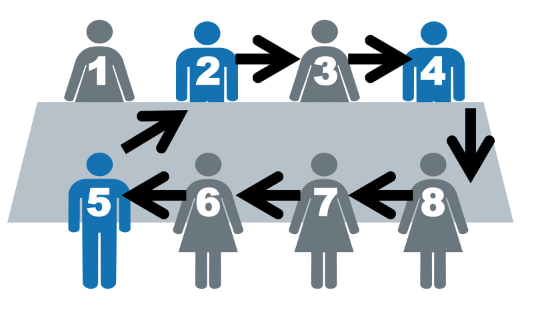The best way to quickly and accurately familiarize yourself with a person is to meet the person, ideally face-to-face, right? Unfortunately, we can’t meet all of our customers face to face. However, we need to understand, design and evaluate experiences for varying customer contexts, needs, goals and attitudes.
As design leaders, it’s our job to make sure stakeholders understand the needs of our customers. We need to enable teams to design and bring new or improved experiences into the world that aren’t designed for those stakeholders, but for the people who will use them. These are the people who purchase products or, in my case, employees, managers and Human Resources professionals who are Honeywell’s main differentiator.
The Role of Personas
To scale an end-to-end user experience mindset and make an impact across an enterprise, most in-house design leaders must develop passionate change agents equipped with understanding of customer needs.
We share Voice of Customer insights to focus prioritization and design on the needs of real people.
However, it is not practical to design experiences to satisfy the needs and idiosyncrasies of tens of thousands of individuals in our enterprise.
Personas are an effective tool we use to embed a human-centered mindset in a way that scales, to get results and deliver sustainable business value.
A Persona is an archetype that represents important, well-researched behavior patterns, motivations, goals and needs of a group of people that share similar qualities.
Personas enable our design teams and business stakeholders with human reference points. This ensures we consider different perspectives as we design experiences for people with varied needs and goals, and in differing contexts. Referring to personas is one way to prevent decision-making based primarily on personal self-reference or assumptions.
We create personas using a few steps:
- Conduct qualitative research, such as contextual inquiries and interviews, using open-ended prompts that address important topics in a problem space.
- Gather a cross-functional team to analyze research findings and extract characteristics of people that relate to the problem space.
- Plot research participants on characteristic continuums, and look for groupings. For instance, we might plot interviewees on a continuum of “Seeks Support” to “Self Support.”
Embedding a Human-centered Mindset, Right & Fast
What is one of several elements often in short supply when bringing new or improved experiences into the world? Time.
You might already use personas in workshops or during projects. As you know, developing quality personas takes time, given the necessary qualitative research and team collaboration. Once developed, personas are most effective when they are “present” and embedded in Design Thinking processes. This also takes time.
I work in a company where team members are in many global locations. When we come together for a face-to-face working session, we need to maximize our use of time.
It is difficult to embed a lasting mindset shift by hanging persona descriptions on walls or around the office, or by distributing a digital format for teams to review. There are a number of ways to integrate personas in design workshops, but I hadn’t found a way that was engaging enough to embed a lasting impression.
As I headed into planning for a recent HR project kickoff, I asked myself, “How might I quickly enable stakeholders to step inside the shoes (or steel-toed boots, sandals or work-at-home slippers) of our personas, to drive a human-centered mindset?”
I decided right and fast, face-to-face immersion is key.
Lasting Impressions Through Persona Speed-Dating
One objective of a recent Human Resources workshop was to embed a human-centered mindset from the start.
I introduced the team to a new way of walking in a customer’s shoes. I call it Persona Speed-Dating. Here’s how it worked.
We formed groups of 8 people and assigned a persona to each person.
- Relate: Each person uses 5 minutes to note key aspects of their persona – to “take on” the attributes of their persona.
- Situate: People position themselves in the prescribed pattern (see Figure 1).
- Date: Each person in a pair uses 1 minute to introduce and describe himself or herself, as their persona might.
- Rotate: Then, with persona 1 remaining in place, personas 2-8 rotate clockwise.
Figure 1
After 20 minutes of “dating,” I asked people to clap if they had learned and embedded key points about each employee persona in their mind. There was boisterous, unanimous applause.
Results
The clapping foreshadowed the feedback received from people who experienced the resulting improvements, and from leaders as they saw productivity and satisfaction increase.
Our teams have realized the benefits of the Persona Speed-Dating method in a number of contexts. Here are several of the outcomes:
- Teams generate more ideas as people consider more varied perspectives
- Team members start using the names of personas in meetings, workshops and presentations, signaling a move from ideation founded on self-referencing and assumptions to ideas driven by validated insights into customer needs
- Teams generate ideas that are human-centered instead of technology-centered
- Spawns additional research to uncover explicit, implicit and latent needs of personas, to drive innovation
Try It
User Experience is about both mindset and methods. Persona Speed-Dating is a fast, novel, fun method to help teams embed a human-centered mindset.
This method pairs nicely with empathy mapping, collaborative sketching and other methods used to generate ideas that address differing customer needs.
Have you tried this, or do you have an idea that might improve this method? Please share, and let’s continue driving a human-centered mindset to deliver measurable business value.








